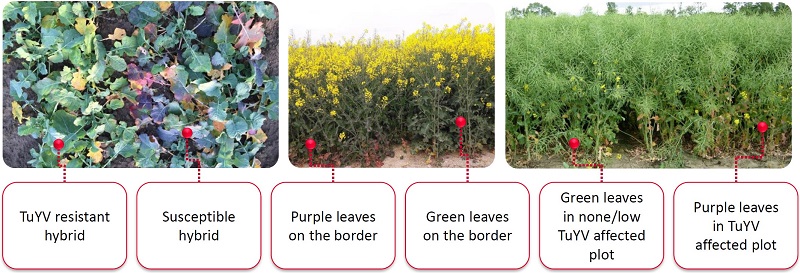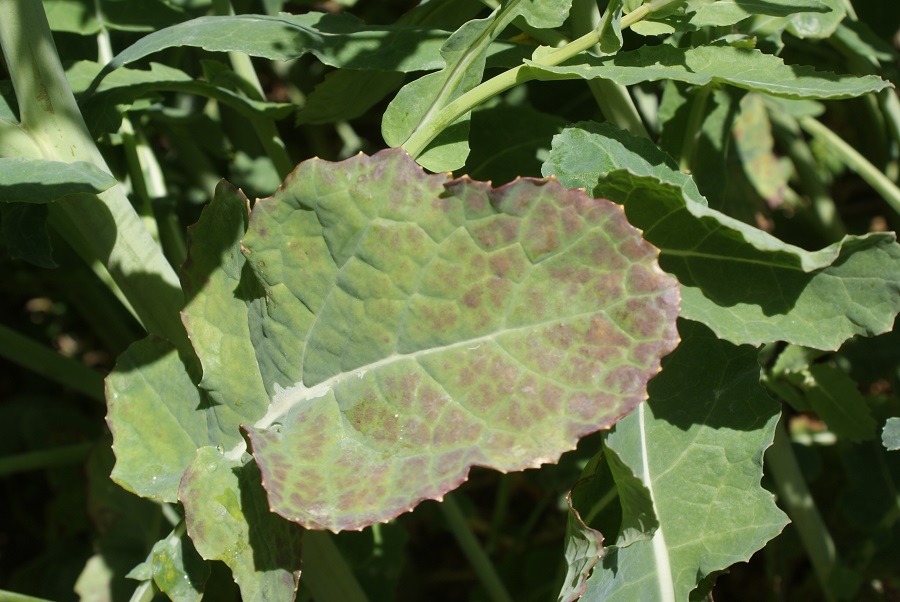Sampling results have revealed turnip yellows virus is endemic across UK oilseed rape crops. CPM explores the evolving story of how plant breeders have built in resistance.
It’s very hard to tell by eye if your crop is infected with TuYV, but it has become the most widespread disease by a country mile.
By Tom Allen-Stevens
There is now a disease that has become a threat for all oilseed rape growers. It’s a virus that can cause up to 30% yield loss for which there is no effective chemical treatment. Turnip yellows virus (TuYV) is transmitted by aphids and it’s believed around 70% of peach potato aphids (Myzus persicae), the most common aphid vector in the UK, carry it.
There is, however, a solution. Look on the AHDB Recommended List and you’ll find no fewer than eight OSR varieties believed to be resistant to TuYV. Five of these are new to the RL this year and sit at the top of the heap. The reason they’re there is reputed to have as much to do with breeding expertise as it does with how the virus itself has spread.

TuYV symptoms showing on susceptible OSR plants at various growth stages as a purple discolouration compared with resistant types.
TuYV has done a fairly effective job at becoming pandemic across most of Europe, but it’s crept up by stealth, notes Prof John Walsh of Warwick University. “In terms of pathogens of oilseed rape, you can see phoma and light leaf spot symptoms quite clearly. It’s very hard to tell by eye if your crop is infected with TuYV, but it has become the most widespread disease by a country mile,” he says.
“It’s spread by a number of aphid vectors, with M. persicae by far the most significant – testing has shown that 70% of the population carries the virus. As well as OSR, the aphid infects various brassica vegetable crops and weeds, so there’s always a green bridge providing a virus reservoir.”
Neonicotinoid seed dressings had been effective at keeping aphids out of arable crops in the early autumn, when aphid flights threatening OSR can hit a peak. But since their removal from use, the proportion of infected OSR crops has grown from just a few hotspots a decade ago to endemic across much of the UK today.
“Infection of OSR is density dependant – there’s a clear correlation between aphid numbers and the proportion of infected plants in crops. The weather in the autumn is crucial, and suction trap data provided by Rothamsted Research show warm conditions drive numbers – we’ve had many favourable autumns for aphids in recent years,” John notes.
Far less is known about exactly what the virus does to a crop. AHDB-funded work conducted by Dr Mark Stevens at BBRO in 2008 found that at an individual crop level, control of TuYV could raise average yields from 3.3t/ha to 4.4-6.0t/ha. “The virus has the effect of reducing both the fresh and dry weight of a crop,” John explains. “Infected plants produce fewer side branches, pods, and seeds per pod. It’s confined to the phloem, so potentially robs the plant of resources that would be fed to the roots.
“But you often don’t see severe symptoms, which is why TuYV often goes undetected. Plant resistance is by far the best way forward.”
Work undertaken at Göttingen University in Germany over two decades succeeded in bringing in genetic resistance. “Researchers recreated OSR, Brassica napus, from its two relatives: B. rapa, which includes turnip and Chinese cabbage, and B. oleracea – cabbage and cauliflower. Some B. oleracea relatives appear to have complete resistance to TuYV. One line of B. napus from Göttingen University, known as R54, was found to have resistance,” continues John.
The pre-breeding research was part-funded by a consortium including major European plant breeders who received germplasm and genetic markers to introduce the trait into commercial lines. “Unlike Rlm7, that confers resistance to phoma, it isn’t known whether it’s one distinct gene. But the molecular markers are 100% successful in identifying whether a variety possesses the resistance.”
The first commercial variety with TuYV resistance was Amalie, introduced into the UK by Limagrain in 2014. Included on the RL, the variety had a yield penalty compared with others, notes Dr Vasilis Gegas, LG’s European portfolio manager.
“Sometimes genetics can give us a solution when nothing else can, and we have to nurture that,” he says. “To AHDB’s credit, Amalie was recognised for its resistance to TuYV, despite being uncompetitive with others on the RL. But genetic resistance is a process that constantly evolves.”
The trait had been introgressed across Limagrain’s European oilseed portfolio, resulting in open-pollinated Aspire, introduced last year, then three new hybrids on the 2020/21 RL – Ambassador, Aurelia and Artemis. “Like Rlm7, TuYV resistance has become the industry standard – it’s a step change for the crop,” says Vasilis.
But there’s a potential problem – all the varieties with the trait stem from the same initial cross, notes John. “There’s currently only this one source of resistance available commercially, and it hasn’t been mapped to a specific gene or subset of genes.”
So research at the University of Warwick, funded by BBSRC for four years, identified new genetic sources of extreme and quantitative resistance. BBSRC have now provided two years of follow-on funding of £200,000, bolstered by cash and in-kind contributions from Limagrain, Elsoms, Syngenta and LSPB to bring the genetic markers and plant lines through to the commercial partners.
Vasilis notes that extensive testing across Europe has shown current resistance is holding up well. “But you never know – the more you rely on it, the greater the risk the virus will overcome genetic resistance.”
He points out that bringing in new traits from exotic sources is a complex and time-consuming process. “We have to be sure the new material is superior and will deliver the right tools to growers – any deployment is not taken lightly.”
But he also has his eyes on the next step – in a further BBSRC-funded project at Warwick, with Limagrain as the sole commercial partner, PhD student Shannon Greer has been taking a close look at Amalie and its progenitor species, identifying and mapping new sources of resistance.
She’s also been assessing the potential interaction between TuYV resistance and tolerance to verticillium wilt. “Although, far from definite there’s now some evidence in support of that,” reports Vasilis. “It could be the Holy Grail of genetic resistance or it could just be that the genes that confer resistance to TuYV also make the plant healthier, and therefore more resilient to other pathogens.
“But just identifying this potential coping mechanism is a big step in itself, and could herald the next wave of trait combinations that will bring to the market varieties with increased resilience to soil-borne threats. I think a sclerotinia-tolerant variety within five years, for instance, is an achievable target.”




